
James Clark was a British racing driver from Scotland, who competed in Formula One from 1960 to 1968. Clark won two Formula One World Drivers' Championship titles with Lotus, and—at the time of his death—held the records for most wins (25), pole positions (33), and fastest laps (28), among others. In American open-wheel racing, Clark won the Indianapolis 500 in 1965 with Lotus, becoming the first non-American winner of the race in 49 years.

British Racing Motors (BRM) was a British Formula One motor racing team. Founded in 1945 and based in the market town of Bourne in Lincolnshire, it participated from 1951 to 1977, competing in 197 grands prix and winning seventeen. BRM won the constructors' title in 1962 when its driver Graham Hill became world champion. In 1963, 1964, 1965 and 1971, BRM came second in the constructors' competition.
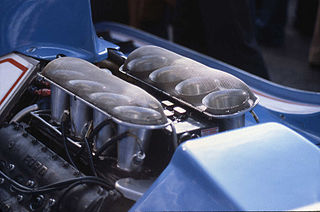
The DFV is an internal combustion engine that was originally produced by Cosworth for Formula One motor racing. The name is an abbreviation of Double Four Valve, the engine being a V8 development of the earlier four-cylinder FVA, which had four valves per cylinder.

The 1968 Formula One season was the 22nd season of the FIA's Formula One motor racing. It featured the 19th World Championship of Drivers, the 11th International Cup for F1 Manufacturers, and three non-championship races open to Formula One cars. The World Championship was contested over twelve races between 1 January and 3 November 1968.
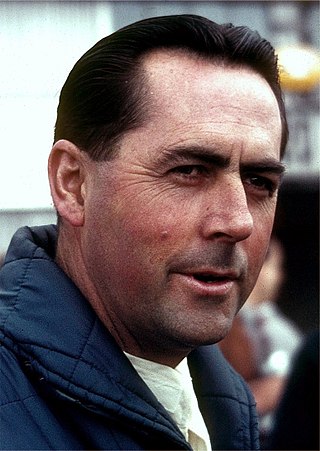
The 1966 Formula One season was the 20th season of FIA Formula One motor racing. It featured the 17th World Championship of Drivers, the 9th International Cup for F1 Manufacturers, and four non-championship races open to Formula One cars. The World Championship was contested over nine races between 22 May and 23 October 1966.

Repco is an Australian automotive engineering/retailer company. Its name is an abbreviation of Replacement Parts Company and was for many years known for reconditioning engines and for specialised manufacturing, for which it gained a high reputation. It is now best known as a retailer of spare parts and motor accessories.

Peter Westbury was a British racing driver from England. He participated in two World Championship Formula One Grands Prix, scoring no championship points. In 1969 he raced a Formula 2 Brabham-Cosworth, driving in his first Grand Prix in the 1969 German Grand Prix. He finished ninth on the road, fifth in the F2 class. The following year he failed to qualify for the 1970 United States Grand Prix driving a works BRM, after an engine failure.

Team Lotus was the motorsport sister company of English sports car manufacturer Lotus Cars. The team ran cars in many motorsport categories including Formula One, Formula Two, Formula Ford, Formula Junior, IndyCar, and sports car racing. More than thirty years after its last race, Team Lotus remained one of the most successful racing teams of all time, winning seven Formula One Constructors' titles, six Drivers' Championships, and the Indianapolis 500 in the United States between 1962 and 1978. Under the direction of founder and chief designer Colin Chapman, Lotus was responsible for many innovative and experimental developments in critical motorsport, in both technical and commercial arenas.

Judd is a brand of racing car engines built by Engine Developments Ltd., a company founded in 1971 by John Judd and Jack Brabham in Rugby, Warwickshire, England. Engine Developments was intended to build engines for Brabham's racing efforts, and became one of the first firms authorised by Cosworth to maintain and rebuild its DFV engines, but has since expanded into various areas of motorsport.

The Lotus 33 was a Formula One car designed by Colin Chapman and Len Terry and built by Team Lotus. A development of the successful Lotus 25, in the hands of Jim Clark it won five World Championship Grands Prix in 1965, taking Clark to his second World Championship.

The Lotus 43 was a Formula One racing car designed by Colin Chapman for the 1966 season. Hampered by its heavy and unreliable BRM engine, it won only one race, the 1966 United States Grand Prix.

The Lotus 38 was the first rear-engined car to win the Indianapolis 500, in 1965, driven by Jim Clark. It was run by Lotus at Indianapolis from 1965 to 1967; a total of 8 were built, most for use by Lotus, but several were sold for use by other drivers, including A. J. Foyt and Mario Andretti.
Four-wheel drive (4WD) has only been tried a handful of times in Formula One. In the World Championship era since 1950, only eight such cars are known to have been built.

The BRM P261, also known as the BRM P61 Mark II, is a Formula One motor racing car, designed and built by the British Racing Motors team in Bourne, Lincolnshire, England. The BRM P261 was introduced for the 1964 Formula One season, and its design was an evolution of Tony Rudd's one-off BRM P61 car of 1963. The P261 had a relatively long racing career; variants of the car were still being entered for Formula One World Championship Grands Prix as late as 1968. During the course of their front-line career, BRM P261s won six World Championship races, in the hands of works drivers Graham Hill and Jackie Stewart, and finished second in both the Drivers' and Constructors' Championship standings in 1964 and 1965. Stewart, Hill and Richard Attwood also used works P261s to compete in the Tasman Series in 1966. The BRMs dominated, with Stewart winning four, Hill two, and Attwood one of the 1966 Tasman Series' eight races. Stewart also won the title. The works-backed Reg Parnell Racing team returned in 1967 with Stewart and Attwood, where Stewart added another two wins to his tally. In terms of races won and total championship points scored, the P261 was the most successful car in BRM's history.
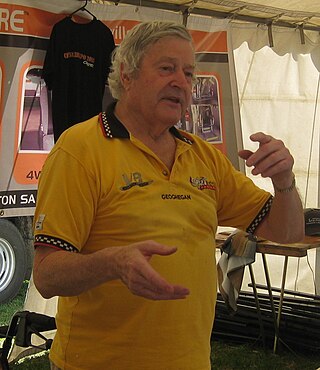
Leo Francis Geoghegan was an Australian racing driver. He was the elder of two sons of former New South Wales car dealer Tom Geoghegan, both of whom become dominant names in Australian motor racing in the 1960s. While his younger brother Ian "Pete" Geoghegan had much of his success in touring car racing, winning five Australian Touring Car Championships, Leo spent most of his racing career in open wheel racing cars.
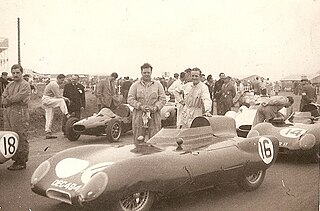
John Crosthwaite was an English race car designer and engineer, active in both the United Kingdom and the United States.

The Lotus 29 was a British racing car built by Team Lotus for the 1963 Indianapolis 500. It was their first attempt at the event and the two cars which were entered finished second and seventh in the hands of Jim Clark and Dan Gurney. Although they were not the first rear-engined cars built for the category, they were first to prove that the configuration was definitely a potential race-winner, and that the days of the big and heavy front-engined roadsters were numbered.

The BRM P83 was a Formula One racing car designed by Tony Rudd and Geoff Johnson and built by British Racing Motors for the new engine regulations of 1966. It used a highly unorthodox H16 engine which caused problems throughout the car's racing life, and despite the best efforts of Graham Hill and Jackie Stewart took BRM from championship contenders to also-rans, leading it to be regarded alongside the BRM Type 15 as another embarrassing failure for the British marque caused by overcomplicated engineering.
The Ford Indy V8 engine is a naturally-aspirated, DOHC, V-8, Indy car racing engine, initially specially designed by Ford for use by Team Lotus, to compete in the Indianapolis 500; from 1963 to 1967. This is the engine that gave Jim Clark the victory in 1965 with his Lotus 38 chassis, Graham Hill victory in 1966 with his Lola T90 chassis, and A. J. Foyt the win at Indianapolis in 1967, in his Coyote 67 chassis.
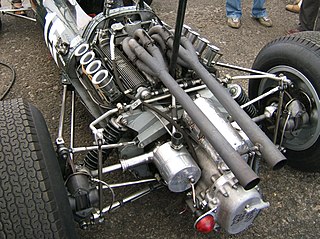
The British Racing Motors V8 was a four-stroke, naturally aspirated, 1.5 L (92 cu in), V-8 racing engine, designed, developed and built by British Racing Motors (BRM) to compete in Formula One racing (although an enlarged 2.0 L version was used for sports car racing. It was built between 1962 and 1967, and came in two version; the P56, and the P60.

















